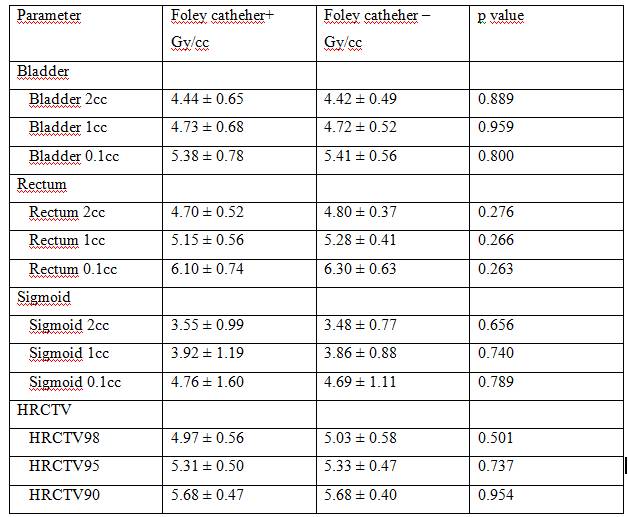THE EFFECT OF BLADDER VOLUME ON THREE-DIMENSIONAL VAGINAL CUFF BRACHYTHERAPY PLANNING
SUMERYA DURU BIRGI,
Turkey
PO-1350
Abstract
THE EFFECT OF BLADDER VOLUME ON THREE-DIMENSIONAL VAGINAL CUFF BRACHYTHERAPY PLANNING
Authors: SUMERYA DURU BIRGI1, OZAN CEM GULER2, YUNUS BABAYIGIT1, YAKUP ARSLAN1, SERAP AKYUREK1
1ANKARA UNIVERSITY FACULTY OF MEDICINE, DEPARTMENT OF RADIATION ONCOLOGY, ANKARA, Turkey; 2ADANA BASKENT UNIVERSITY, DEPARTMENT OF RADIATION ONCOLOGY, ADANA, Turkey
Show Affiliations
Hide Affiliations
Purpose or Objective
OBJECTIVE: It is considered appropriate to simulate an
empty bladder and rectum before
treatment planning of vaginal cuff brachytherapy. However, the use of a
Foley catheter to empty the bladder in each fraction can affect the treatment
compliance and quality of life of the patients. In this study, it was aimed to
determine the effect of Foley catheter on bladder fullness and the changes
caused by the doses received by other critical organs and target volumes in
patients who underwent vaginal cuff BRT.
Material and Methods
MATERIAL
METHODS: Twenty patients with a diagnosis of postoperative endometrial or
cervical cancer who underwent 3-dimensional vaginal high-dose rate (HDR-BRT)
using a multi-channel cylinder between January 2020 and May 2021 were examined
dosimetrically. Rectum emptied using enema in all patients before the first
fraction. After evacuation of the urine, two simulation CT scans were performed
with and without inserting a foley catheter. Target volumes and critical organs
were contoured in accordance with the guidelines in both treatment planning CT scan
slices. The treatment plan, which was approved in the planning CT with the
Foley, was transferred to the CT withoutFolet, and the dose volume histogram
(DVH) parameters were evaluated separately. For both planning, first of all,
the volumes of HRCTV and critical organs and the D90, D95 and D98 values
obtained by HRCTV; also the doses of 0.1 cc, 1 cc and 2 cc of each critical
organ like bladder, rectum and sigmoid were recorded separately. Paired sample
t-test was used to determine the statistical difference between both planning
DVH parameters, p>0.05 was considered significant.
Results
RESULTS:
The median age of the patients was 60 years (35-79). The median ECOG
performance score was 1 (0-2) and 75% (n=15) had additional comorbidities. Half
of the patients were obese, and the median body mass index (BMI) in all
patients was 34 kg/m2 (20-40). Vaginal cuff BRT was applied to 16 patients
diagnosed with endometrial cancer and 4 patients with cervical cancer. Median
50.4 Gy (45-50.4 Gy) external RT was applied to 12 patients with a total of 15
Gy BRT boost in 3 fractions. A total of 27.5 Gy HDR-BRT in 5 fractions was
applied to 8 endometrial cancer patients. No significant difference was found
between target and critical organ volumes when the DVH parameters of the
planning with and without the Foley catheter were evaluated. In addition, no
statistically significant difference was found between the two plans in terms
of target and critical organ doses such as HRCTV D90, D95, D98 and D0.1, D1,
D2cc of critical organs. DVH information related to volume and doses are
summarized in Table-1.
Table-1. Dosimetric analysis of target volumes and organs at risk

Conclusion
CONCLUSION:
It is not necessary to empty the bladder by inserting a Foley catheter before
the vaginal cuff BRT treatment.It seems to be sufficient to simulate and treat
the patient by just emptying the urine.